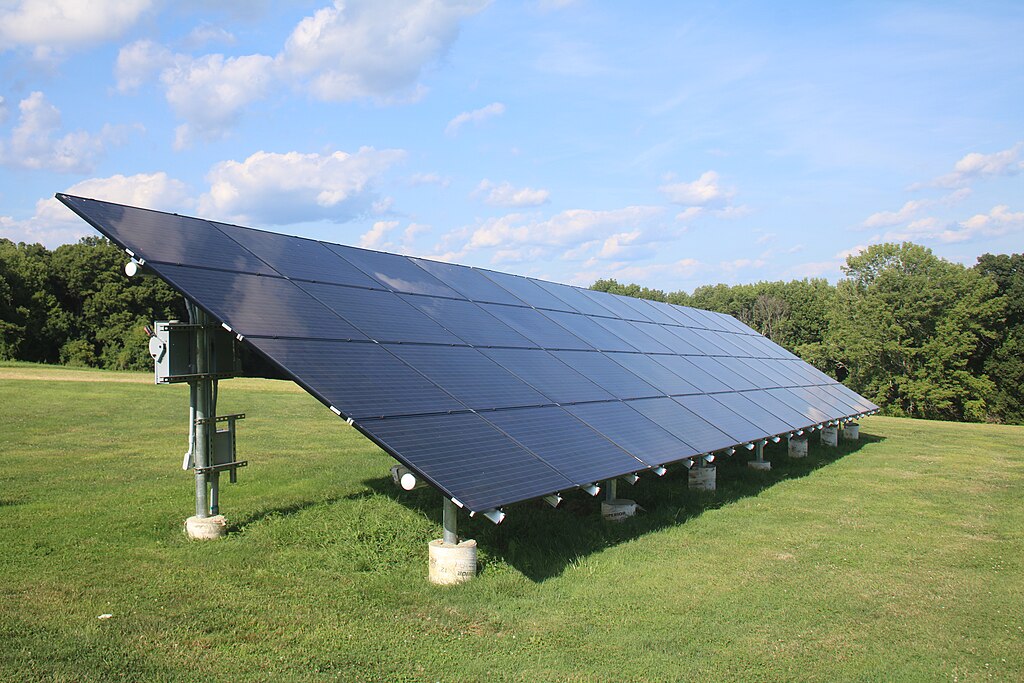Knowing the unknowns

Solar panels in Connecticut. Georgia Tech’s Caleb Ju has developed an optimization model that could predict the ebb and flow of solar power and balance it with price, even during the more volatile winter months. (Photo: Grendelkhan via Wikimedia Commons.)
Real-world modeling problems are rife with uncertainty and complicated interactions. To maximize profits, companies consider resource availability, environmental consequences, tax repercussions and ever-changing supply and demand. Caleb Ju of Georgia Institute of Technology uses a combination of mathematics and computer science to solve multiple-variable problems. Sometimes, the results are surprising.
Ju, a Department of Energy Computational Science Graduate Fellowship recipient, enjoys using computers to solve math problems. “I really liked it when it gave me an answer that I didn’t expect. There’s the story behind it that I couldn’t have discovered myself.”
Advised by Guanghui Lan, Ju uses optimization to solve complex decision-making problems that dynamically change random variables, in fields such as healthcare, robotics, or weather forecasting for renewable energy. His strategy employs a trial-and-error form of machine learning called reinforcement learning that adjusts assumptions based on data received in real time.
In these situations, Ju explains, “You need to make decisions, but you also need to make decisions under uncertainty. Traditionally, I think people often separate the two.”
To boost renewable energy profits, companies must balance how much power can be generated and used immediately versus what can be stored in lithium-ion batteries to provide electricity during low-production periods. Ju developed an optimization model that could predict the ebb and flow of solar power and balance it with price, even during the more volatile winter months.
Solar energy is abundant during summer’s long days. Panels generate less energy overall in the winter, and the smaller load is more sensitive to changing availability. Despite this uncertainty, Ju’s model performed well. “What surprised us was that reinforcement learning seemed to learn to predict prices relatively well on its own during the training process,” even during the winter months, Ju says. His methods achieved a 6 to 13% increase in profits over traditional methods. Energy companies don’t use reinforcement learning currently, Ju says, but results like these show the potential benefits.
In models with many unknown variables, noise can often overwhelm the signal and make predictions less accurate. But reinforcement learning can help researchers understand noise and keep it from obscuring meaningful conclusions. When modeling renewable energy, Ju noticed that his approach picked up on small trends hidden by noise. Surprisingly, Ju’s model didn’t just predict when future prices change but also revealed how volatile they are, helping them find sources of greater profits.
Ju dug deeper into optimization during two practicums at DOE national labs. At the National Renewable Energy Laboratory, he used optimization to make binary decisions such as determining whether a generator should be switched off or on. Such decisions are typically more challenging than continuous ones like determining a generator’s operating efficiency. “Whenever you can slide the knob, that wiggle room gives you a lot of flexibility” in developing algorithms, he says.
During his second practicum at Lawrence Berkeley National Laboratory, he worked on speeding up optimization calculations, whose large matrices can require significant time and computing resources to solve. Here he incorporated noise again, but to help algorithms make more accurate approximations, which can lead to faster, less costly solutions.
Ju’s love of optimization extends to one of his hobbies: cooking. Part of the appeal, he admits, was to save money in his graduate school years. But he came to enjoy cooking because it’s similar to math and coding. “In the beginning, it’s a little bit difficult, but once you learn the principles, you can spin off and make your own thing,” he says. “You try to stick to those principles, but you know when to break them.”
About the Author
Elizabeth Fernandez is a freelance science writer with a Ph.D. in astronomy from the University of Texas. She writes about astronomy, geology, chemistry, physics, mathematics, climate change and AI.





You must be logged in to post a comment.